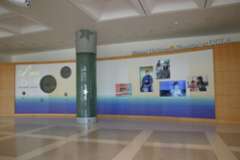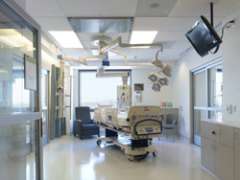Designed for Comfort and Efficiency
Renowned architects I.M. Pei and C.C. Pei of Pei Partnership Architects designed the Ronald Reagan UCLA Medical Center, with the firm of Perkins & Will serving as the executive architect. Their vision-and that of UCLA--was to achieve an environment that optimizes healing through adaptive use of the latest technology and design know-how. The hospital boasts many features that exemplify that commitment:

The hospital's design is open and light-filled, organized in pavilions with glass walls facing outdoors, and includes gardens and gathering places that surround the new building. Individual patient rooms all feature windows that afford panoramic views and also bring in an abundance of natural, healing light.
To give the intimate feel of a smaller hospital, the facility consists of four separate towers and those towers are staggered to avoid windows looking directly in on each other. All patient rooms are private and feature window seats that convert to daybeds, allowing family members to room-in with patients.
A unique feature of the Resnick Neuropsychiatric Hospital is the use of outdoor patios for patients and families. The outdoor patio features an area to conduct group therapy sessions built right into the hardscape. The Mattel Children's Hospital boasts a large outdoor play terrace which extends outside the children's indoor play spaces. Here, children may safely play and enjoy the healing effects of natural light.

The Mattel Children's Hospital also features three age-appropriate playrooms for babies, small children, and teens. The entrance room is circular and features a map of the world and a large cylindrical aquarium. These kinds of child-friendly spaces offer comfort and support for the social and emotional needs of children and families in the hospital. Finally, the separate entrance to children's hospital features a "welcome wall" that incorporates artwork and video screens. The video screens showcase stories of staff, patients, and families to welcome and comfort visitors and to provide a less intimidating entrance for children.
Maximum efficiency and flexibility of function is built into every patient room. Each has the capability to convert into an intensive care unit (ICU) to allow for the continuous care of a critically ill patient in one room. Indeed, physicians and nurses are able to perform many procedures in the individual rooms, instead of having to move patients around the hospital.
Every floor harbors a number of ICU rooms.

These are laid out so that the bed is in the center of the room allowing staff to treat a patient from all sides. In the event that a patient needs to be moved from an ICU room to surgery, the ceiling boom in an ICU room has an equipment arm and portable trolley with battery that detaches and can go with the patient, saving critical preparation-for-transport time. All of these features are built into each room to allow the rooms to function as needs develop.
Unlike most hospitals, every floor here is dedicated to a particular specialty and all of the support equipment and supplies for those patients is located on the very same floor. Crisscrossing corridors in the nurses' area make access to the supplies equal-distance from any of the patient rooms. Finally, every floor has its own satellite pharmacy, dialysis storage, respiratory therapy workrooms, and resident doctor sleep rooms, making every floor nearly self-sufficient.
The latest wireless technology has been installed so that the hospital is paperless, that is, it uses advanced communication technologies that provide both medical professionals and patients better access to relevant medical records and research data. Clinical staff has access to electronic patient charts at every bedside. Patients and visitors have wireless Internet access throughout the building. And, wireless digital technology makes it possible to boast a film-less imaging environment.
At the Ronald Reagan UCLA Medical Center, surgeons are operating in the largest complex of integrated operating rooms built to-date, using the most advanced surgical concepts with full audiovisual integration systems. UCLA collaborated with three groups - engineers, physicians, and industry members - to shape these, the surgical suites of tomorrow. Using voice-activated controls, surgeons can select from 3 camera feeds, annotate over images, record a procedure on DVD, control all lights, bring up any data, and even participate in a video conference with other doctors at a remote location during surgery. All of this computerized communication technology--not to mention cutting-edge medical equipment--is enhanced by the use of a special green light that allows for better vision instead of standard white light.
Finally, because UCLA is a Level One trauma center, we see a lot of trauma cases. The Emergency Department has multiple trauma rooms, as well as a dedicated CT scanner enabling doctors to identify what's wrong with patients immediately upon their arrival. Specially designed trauma elevators are large enough to allow a transport team to treat a patient while the patient is being moved from the helicopter landing area on the roof down to the emergency dept. They also carry critically ill patients from the emergency room up one floor to the operating room, and up again to any of the ICU rooms.